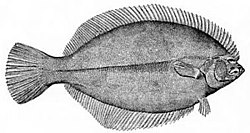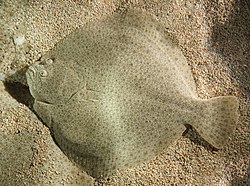| Large-tooth flounders Temporal range: | |
|---|---|
 | |
| Summer flounder (Paralichthys dentatus) | |
| Scientific classification | |
| Kingdom: | Animalia |
| Phylum: | Chordata |
| Class: | Actinopterygii |
| Order: | Carangiformes |
| Suborder: | Pleuronectoidei |
| Family: | Paralichthyidae Regan, 1910 |
| Type genus | |
| Paralichthys Girard, 1858 | |
| Genera [1] | |
See text | |
Large-tooth flounders or sand flounders are a family, Paralichthyidae, of flounders. [1] [2] The family contains 14 genera with a total of about 110 species. They lie on the sea bed on their right side; both eyes are always on the left side of the head, while the Pleuronectidae usually (but not always) have their eyes on the right side of the head. [3]
They are found in temperate and tropical waters of the Atlantic, Indian and Pacific Oceans. [4] Several species are important commercial and game fishes, notably the California halibut, Paralichthys californicus.




